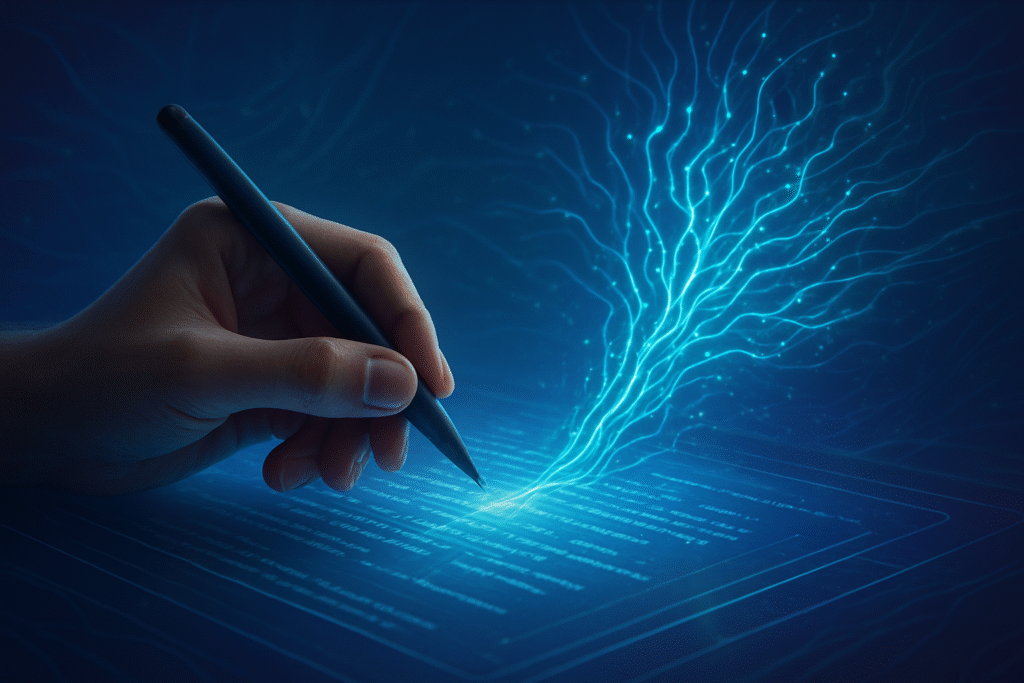
The integration of Artificial Intelligence (AI) into the realm of creative writing is rapidly transforming the literary landscape, offering authors unprecedented tools to overcome creative hurdles and accelerate content creation. From battling writer's block to generating intricate plotlines and drafting entire narratives, AI-powered assistants are becoming increasingly sophisticated collaborators in the art of storytelling. This technological evolution carries immediate and profound significance for individual authors, promising enhanced efficiency and new avenues for creative exploration, while simultaneously introducing complex ethical, legal, and economic challenges for the broader publishing sector and society at large.
The immediate impact is a dual-edged sword: while AI promises to democratize writing and supercharge productivity, it also sparks fervent debates about originality, intellectual property, and the very essence of human creativity in an age where machines can mimic human expression with startling accuracy. As of October 27, 2025, the industry is grappling with how to harness AI's potential while safeguarding the invaluable human element that has long defined literary art.
Detailed Technical Coverage: The Engines of Imagination
The current wave of AI advancements in creative writing is primarily driven by sophisticated Large Language Models (LLMs) and transformer-based deep neural networks. These models, exemplified by OpenAI's (NASDAQ: OPEN) GPT-3, GPT-4o, Google's (NASDAQ: GOOGL) Gemini, and Anthropic's Claude, boast vast parameter counts (GPT-3 alone had 175 billion parameters) and are trained on immense datasets of text, enabling them to generate human-like prose across diverse topics. Unlike earlier AI systems that performed basic rule-based tasks or simple grammar checks, modern generative AI can create original content from scratch based on natural language prompts.
Specific tools like Sudowrite, Jasper.ai, Copy.ai, and NovelCrafter leverage these foundational models, often with custom fine-tuning, to offer specialized features. Their technical capabilities span comprehensive content generation—from entire paragraphs, story outlines, poems, and dialogues to complete articles or scripts. They can mimic various writing styles and tones, allowing authors to experiment or maintain consistency. Some research even indicates that AI models, when fine-tuned on an author's work, can generate text that experts rate as more stylistically accurate than that produced by human imitators. Furthermore, AI assists in brainstorming, content refinement, editing, and even research, providing data-driven suggestions for improving readability, clarity, and coherence. The multimodal capabilities of newer systems like GPT-4o, which can process and generate text, images, and audio, hint at a future of integrated storytelling experiences.
This generative capacity marks a significant divergence from previous writing aids. Traditional word processors offered basic formatting, while early grammar checkers merely identified errors. Even advanced tools like early versions of Grammarly or Hemingway Editor primarily corrected or suggested improvements to human-written text. Modern AI, however, actively participates in the creative process, drafting extensive content in minutes that would take human writers hours, and understanding context in ways traditional tools could not. Initial reactions from the AI research community and industry experts are a mix of awe and apprehension. While acknowledging the breakthrough sophistication and potential for enhanced creativity and productivity, concerns persist regarding AI's capacity for true originality, emotional depth, and the risk of generating generic or "soulless" narratives.
Corporate Crossroads: How AI Reshapes the Creative Market
The integration of AI into creative writing is creating a dynamic and highly competitive market, benefiting a diverse range of companies while simultaneously disrupting established norms. The global AI content writing tool market is projected for explosive growth, with estimates reaching nearly $19 billion by 2034.
AI writing tool providers and startups like Jasper, Writesonic, Copy.ai, and Anyword are at the forefront, offering specialized platforms that prioritize efficiency, SEO optimization, and content ideation. These companies enable users to generate compelling content rapidly, allowing startups to scale content creation without extensive human resources. Publishing houses are also exploring AI to automate routine tasks, personalize content recommendations, and streamline workflows. Some are even negotiating deals with generative AI model providers, seeing AI as a means to expand knowledge sources and enhance their operations. Marketing agencies and e-commerce businesses are leveraging AI for consistent, high-quality content at scale, assisting with SEO, personalization, and maintaining brand voice, thereby freeing human teams to focus on strategy.
Major tech giants like Google (NASDAQ: GOOGL) with Gemini, and OpenAI (NASDAQ: OPEN) with ChatGPT and GPT-4, are solidifying their dominance through the development of powerful foundational LLMs that underpin many AI writing applications. Their strategy involves integrating AI capabilities across vast ecosystems (e.g., Gemini in Google Workspace) and forming strategic partnerships (e.g., OpenAI with Adobe) to offer comprehensive solutions. Companies with access to vast datasets hold a significant advantage in training more sophisticated models, though this also exposes them to legal challenges concerning copyright infringement, as seen with numerous lawsuits against AI developers. This intense competition drives rapid innovation, with companies constantly refining models to reduce "hallucinations" and better mimic human writing. The disruption is palpable across the publishing industry, with generative AI expected to cause a "tectonic shift" by automating article generation and content summarization, potentially impacting the roles of human journalists and editors. Concerns about market dilution and the commodification of creative work are widespread, necessitating a redefinition of roles and an emphasis on human-AI collaboration.
Broader Strokes: AI's Place in the Creative Tapestry
AI's role in creative writing is a pivotal element of the broader "generative AI" trend, which encompasses algorithms capable of creating new content across text, images, audio, and video. This marks a "quantum leap" from earlier AI systems to sophisticated generative models capable of complex language understanding and production. This shift has pushed the boundaries of machine creativity, challenging our definitions of authorship and intellectual property. Emerging trends like multimodal AI and agentic AI further underscore this shift, positioning AI as an increasingly autonomous and integrated creative partner.
The societal and ethical impacts are profound. On the positive side, AI democratizes writing, lowers barriers for aspiring authors, and significantly enhances productivity, allowing writers to focus on more complex, human aspects of their craft. It can also boost imagination, particularly for those struggling with initial creative impulses. However, significant concerns loom. The risk of formulaic content, lacking emotional depth and genuine originality, is a major worry, potentially leading to a "sea of algorithm-generated sameness." Over-reliance on AI could undermine human creativity and expression. Furthermore, AI systems can amplify biases present in their training data, leading to skewed content, and raise questions about accountability for problematic outputs.
Perhaps the most contentious issues revolve around job displacement and intellectual property (IP). While many experts believe AI will augment rather than fully replace human writers, automating routine tasks, there is apprehension about fewer entry-level opportunities and the redefinition of creative roles. Legally, the use of copyrighted material to train AI models without consent has sparked numerous lawsuits from prominent authors against AI developers, challenging existing IP frameworks. Current legal guidelines often require human authorship for copyright protection, creating ambiguity around AI-generated content. This situation highlights the urgent need for evolving legal frameworks and ethical guidelines to address authorship, ownership, and fair use in the AI era. These challenges represent a significant departure from previous AI milestones, where the focus was more on problem-solving (e.g., Deep Blue in chess) or data analysis, rather than the generation of complex, culturally nuanced content.
The Horizon of Narrative: What's Next for AI and Authorship
The future of AI in creative writing promises a trajectory of increasing sophistication and specialization, fundamentally reshaping how stories are conceived, crafted, and consumed. In the near term, we can anticipate the emergence of highly specialized AI tools tailored to specific genres, writing styles, and even individual authorial voices, demonstrating a more nuanced understanding of narrative structures and reader expectations. Advancements in Natural Language Processing (NLP) will enable AI systems to offer even more contextually relevant suggestions, generate coherent long-form content with greater consistency, and refine prose with an almost human touch. Real-time collaborative features within AI writing platforms will also become more commonplace, fostering seamless human-AI partnerships.
Looking further ahead, the long-term impact points towards a radical transformation of entire industry structures. Publishing workflows may become significantly more automated, with AI assisting in manuscript evaluation, comprehensive editing, and sophisticated market analysis. New business models could emerge, leveraging AI's capacity to create personalized and adaptive narratives that evolve based on reader feedback and engagement, offering truly immersive storytelling experiences. Experts predict the rise of multimodal storytelling, where AI systems seamlessly integrate text, images, sound, and interactive elements. The biggest challenge remains achieving true emotional depth and cultural nuance, as AI currently operates on patterns rather than genuine understanding or lived experience. Ethical and legal frameworks will also need to rapidly evolve to address issues of authorship, copyright in training data, and accountability for AI-generated content. Many experts, like Nigel Newton, CEO of Bloomsbury, foresee AI primarily as a powerful catalyst for creativity, helping writers overcome initial blocks and focus on infusing their stories with soul, rather than a replacement for the human imagination.
Final Chapter: Navigating the AI-Powered Literary Future
The integration of AI into creative writing represents one of the most significant developments in the history of both technology and literature. Key takeaways underscore AI's unparalleled ability to augment human creativity, streamline the writing process, and generate content at scale, effectively tackling issues like writer's block and enhancing drafting efficiency. However, this power comes with inherent limitations: AI-generated content often lacks the unique emotional resonance, deep personal insight, and genuine originality that are the hallmarks of great human-authored works. The prevailing consensus positions AI as a powerful co-creator and assistant, rather than a replacement for the human author.
In the broader context of AI history, this marks a "quantum leap" from earlier, rule-based systems to sophisticated generative models capable of complex language understanding and production. This shift has pushed the boundaries of machine creativity, challenging our definitions of authorship and intellectual property. The long-term impact on authors and the publishing industry is expected to be transformative. Authors will increasingly leverage AI for idea generation, research, and refinement, potentially leading to increased output and new forms of storytelling. However, they will also grapple with ethical dilemmas surrounding originality, the economic pressures of a potentially saturated market, and the need for transparency in AI usage. The publishing industry, meanwhile, stands to benefit from streamlined operations and new avenues for personalized and interactive content, but must also navigate complex legal battles over copyright and the imperative to maintain diversity and quality in an AI-assisted world.
In the coming weeks and months, the industry should watch for several key developments: further advancements in multimodal AI that integrate text, image, and sound; the evolution of "agentic AI" that can proactively assist writers; and, crucially, the progress in legal and ethical frameworks surrounding AI-generated content. As OpenAI (NASDAQ: OPEN), Google (NASDAQ: GOOGL), and other major players continue to release new models "good at creative writing," the dialogue around human-AI collaboration will intensify. Ultimately, the future of creative writing will depend on a delicate balance: leveraging AI's immense capabilities while fiercely preserving the irreplaceable human element—the unique voice, emotional depth, and moral imagination—that truly defines compelling storytelling.
This content is intended for informational purposes only and represents analysis of current AI developments.
TokenRing AI delivers enterprise-grade solutions for multi-agent AI workflow orchestration, AI-powered development tools, and seamless remote collaboration platforms.
For more information, visit https://www.tokenring.ai/.







